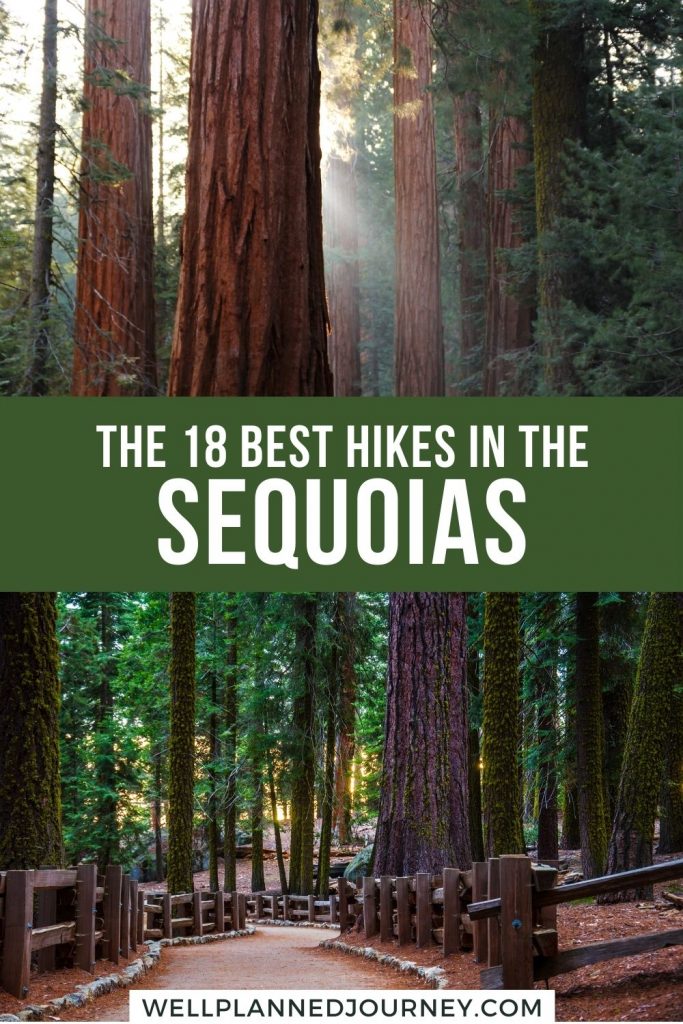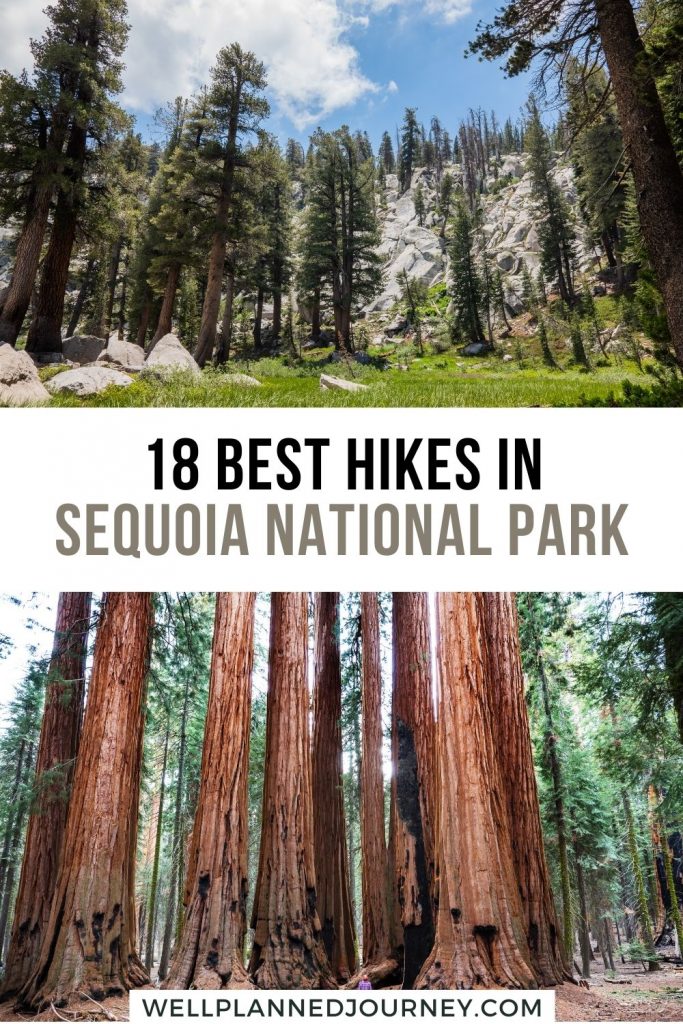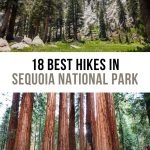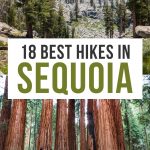Sequoia National Park has quiet sequoia groves, spectacular sunset views, and alpine lakes. One of the best ways to explore this bucket list park up close is on a hike.
Taking a stroll in Sequoia National Park grants you access to some of the world’s most giant trees and helps you escape the crowds.
In Sequoia, you’ll find miles upon miles of trails. So how do you choose what hikes to add to your Sequoia National Park itinerary? That’s precisely why I’ve put together this guide on the best hikes in Sequoia National Park.
This post covers everything your need to know for choosing the best Sequoia National Park hikes, including how to get to the park, where to stay, and tips for a successful hike amongst the Sequoias.
This post may contain affiliate links, where I may receive a small commission at no additional cost to you. Read more in this disclosure policy.
Sequoia & Kings Canyon At-A-Glance
Before diving in, here are a few highlights to help you plan your trip:
- Best Time to Visit: Summer is the best time to visit both these national parks. From June to September, all park roads are open and the weather is perfect for hiking. If you’re looking to avoid crowds, consider visiting in May or October instead.
- Where to Stay: If you’re looking to stay in the park, you’ll have plenty of lodges and campgrounds to choose from. I recommend Wuksachi Lodge in Sequoia or Cedar Grove Lodge in Kings Canyon. Outside the parks, book a spot nearby The Parks Inn Bed & Breakfast.
- How to Get There: The closest airport is in Fresno, California. You can also fly into San Francisco or Oakland, both 4 hours away. Use Expedia to browse flights and find the best price.
- How to Get Around: The easiest way to get around both Sequoia and Kings Canyon is in your own car. Use Expedia to browse deals on rental cars or rent an RV or campervan with Outdoorsy.
- Don’t Forget: Be sure to get an America the Beautiful National Park Pass ahead of time. This $80 pass is valid for 12 months and get you into all 400+ national park sites (including both Sequoia and Kings Canyon!)
Getting to Sequoia National Park
Sequoia National Park lies in the Sierra Nevada Mountains in central California. To get here, you’ll need to drive several hours from most major cities.
You’ll find Los Angeles, Sacramento, San Francisco, and Oakland airports about 5 hours away from the park.
The closest airport to Sequoia National Park is in Fresno, just under 2 hours away from the park’s center. Most major airlines, including Delta, American, United, Alaska, and Southwest, service Fresno Yosemite International Airport (FAT).
I use Expedia to find the best flight prices and compare routes. Once you find your flight, you can book directly through Expedia to save money, but still enter your frequent flyer numbers to get points!
If you need a rental car, I also recommend using Expedia to find the best deals across brands like Avis, Hertz, Enterprise, Budget, and more.
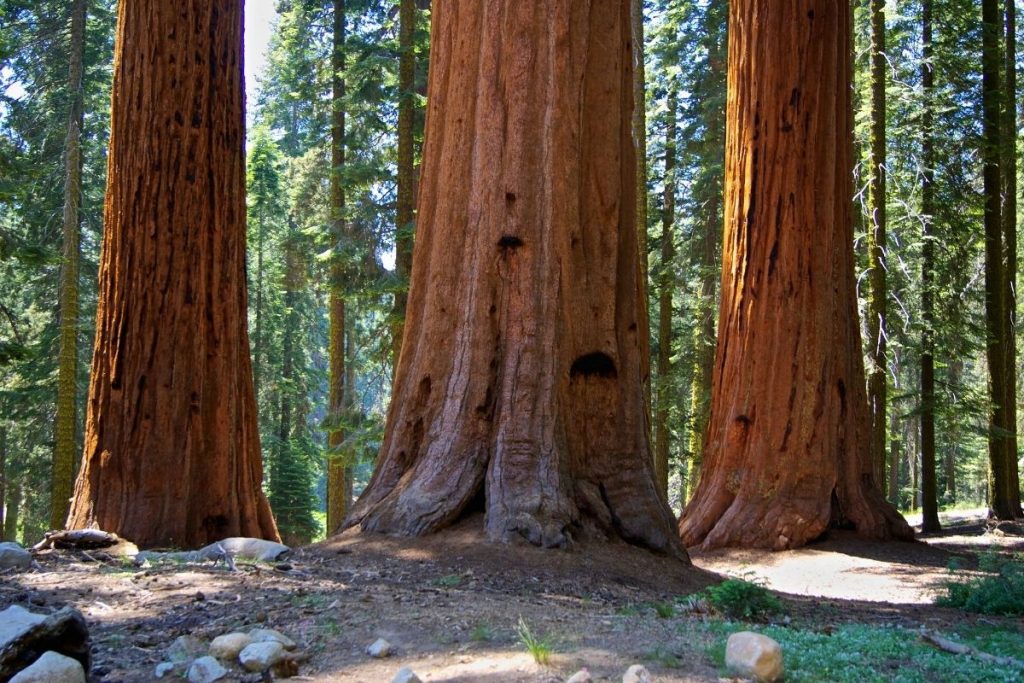
Sequoia National Park Entry Fees
Entry to Sequoia National Park requires a fee. You have a few options:
- America the Beautiful National Park Pass
- Best deal if you plan to visit multiple parks in the next year
- Valid for 12 months
- Admits you to all 63 national parks, plus 400 more monuments and sites
- Able to purchase online in advance to save time at the park
- Cost: $80
- 7-Day Sequoia & Kings Canyon National Park Pass
- Valid for seven days for both Sequoia and Kings Canyon parks
- Can be purchased at the entrance station upon arrival
- Cost: $35
- Annual Sequoia National Park Pass
- Valid for 12 months only for Sequoia & Kings National Park
- It only makes sense if you plan on visiting Sequoia or Kings Canyon more than once in the next year
- Can be purchased at the entrance station upon arrival
- Cost: $70
Are you visiting multiple national parks in the next year? The America the Beautiful National Park Pass gets you into 400+ national park sites, including all 63 national parks, for 12 months!
Get your national park pass ahead of time for only $80.
Where to Stay Near the Sequoia Hikes
Sequoia National Park offers a mix of both lodges and campgrounds inside the park.
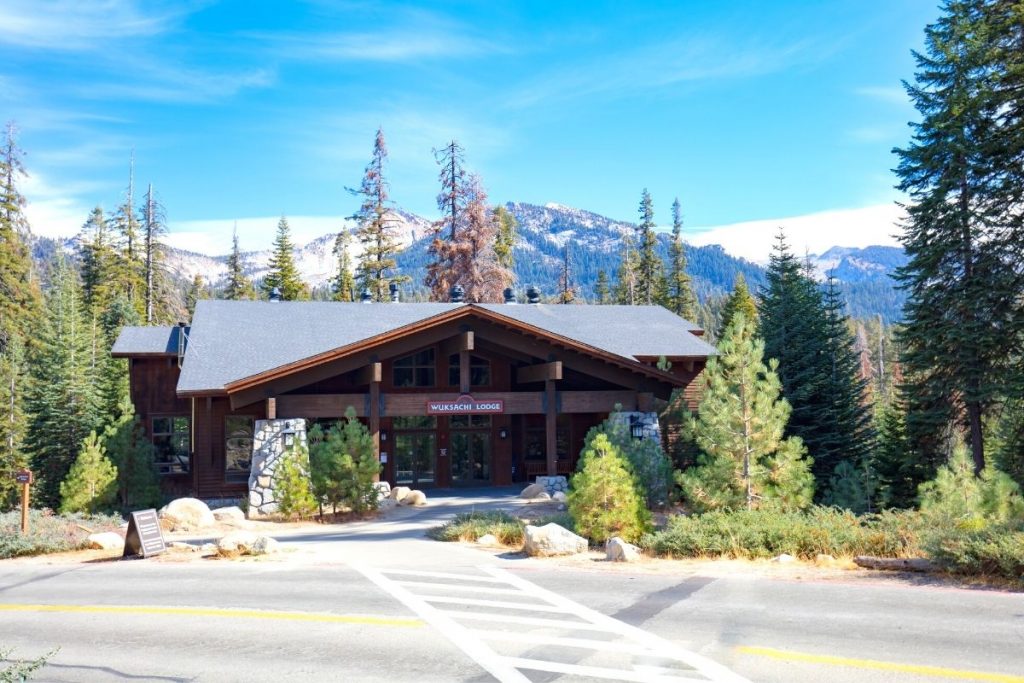
The only lodge inside Sequoia National Park is the Wuksachi Lodge. This rustic lodge offers excellent proximity to many of Sequoia National Park’s best attractions, including the General Sherman Tree and Giant Forest and the park visitor center.
This interactive map can help you search all the available hotels and rental properties near Sequoia & Kings Canyon National Parks! Simply scroll and click the map below to see what is available!
If you want to stay inside the nearby Kings Canyon National Park or Sequoia National Forest, the best spots close to hiking in Sequoia are:
- John Muir Lodge (Kings Canyon)
- Grant Grove Cabins (Kings Canyon)
- Montecito Sequoia Lodge (Sequoia National Forest)
- Stony Creek Lodge (Sequoia National Forest)
Staying outside the park will be more budget-friendly but will add a bit of commute time to get to the heart of Sequoia National Park. I recommend these spots near the park:
- Rio Sierra Riverhouse (Three Rivers)
- Lazy J Ranch Motel (Three Rivers)
- The Parks Inn Bed and Breakfast (Lemon Cove)
- Comfort Inn & Suites Sequoia Kings Canyon (Three Rivers)
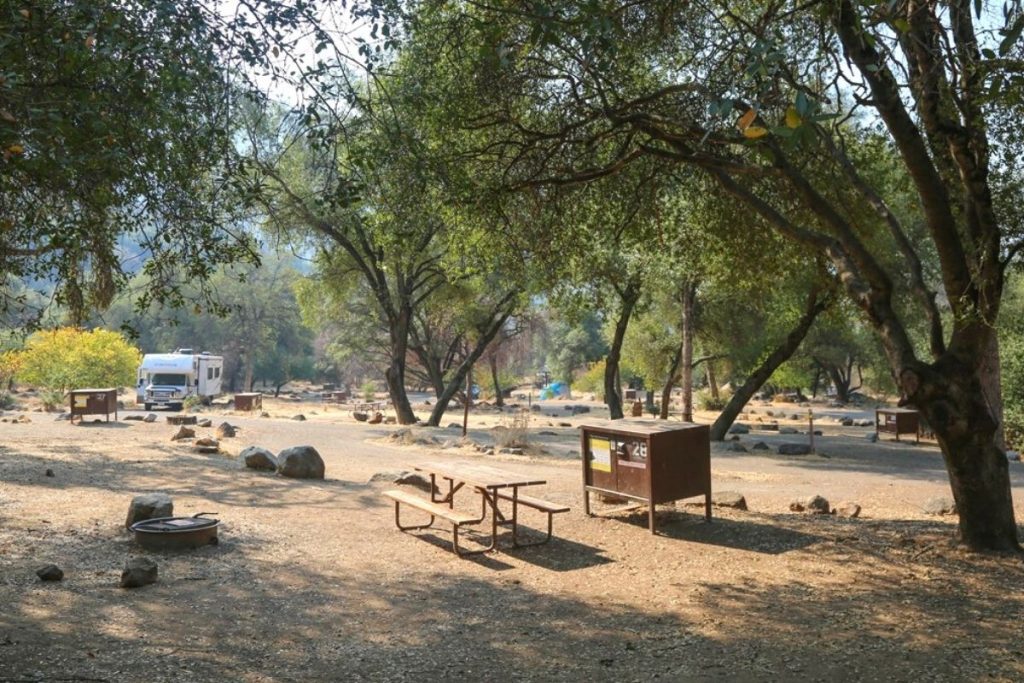
Sequoia National Park also offers seven campgrounds inside the park, not including sites in nearby Kings Canyon’s Cedar Grove and Grant Grove. Many of these campgrounds provide excellent access to the park’s most popular trailheads via the park shuttle.
- Lodgepole Campground (Lodgepole)
- Dorst Creek Campground (Lodgepole)
- Potwisha Campground (Foothills)
- Buckeye Flat Campground (Foothills)
- South Fork Campground (Foothills)
- Cold Springs Campground (Mineral King)
- Atwell Mill Campground (Mineral King)
For more details, check out my posts on camping in Sequoia National Park and camping in Kings Canyon National Park.
What to Pack for Hiking in Sequoia National Park
- Hiking Backpack and the 10 Essentials | It’s essential to carry safety gear every time you hike. Be sure to pack the ten hiking essentials and bring a hiking backpack with plenty of room for water and extra equipment.
- Trekking Poles | These are a great way to reduce the impact on hikes with lots of elevation gain. I have the REI carbon fiber poles, a perfect lightweight set for any kind of hike.
- Hiking Boots | You’ll want sturdy, comfortable hiking boots or trail shoes with solid traction. Don’t forget to break in your boots before your trip!
- Merino Wool Socks | Always opt for merino wool socks. They might be a bit expensive, but they will last a long time, keep your feet dry, and protect you from blisters.
- Headlamp | If you plan on hiking for sunrise or sunset, you’ll need a headlamp to keep you safe when walking in the dark. I highly recommend the Black Diamond Storm headlamp.
- Layers | Pack moisture-wicking hiking shirts and warm fleece layers to keep you comfortable all day.
- Sun Hat and Sunscreen | Many trails are unshaded, so it’s essential to protect yourself from the sun. Of course, sunscreen is necessary, but a sun hat will go a long way towards protecting you from sunburn too.
Looking for more tips on what to pack for your trip? Check out my guides on the best hiking gear, what to pack for a road trip, and essential camping gear for all my favorite gear picks and tips to make packing for your trip a breeze!
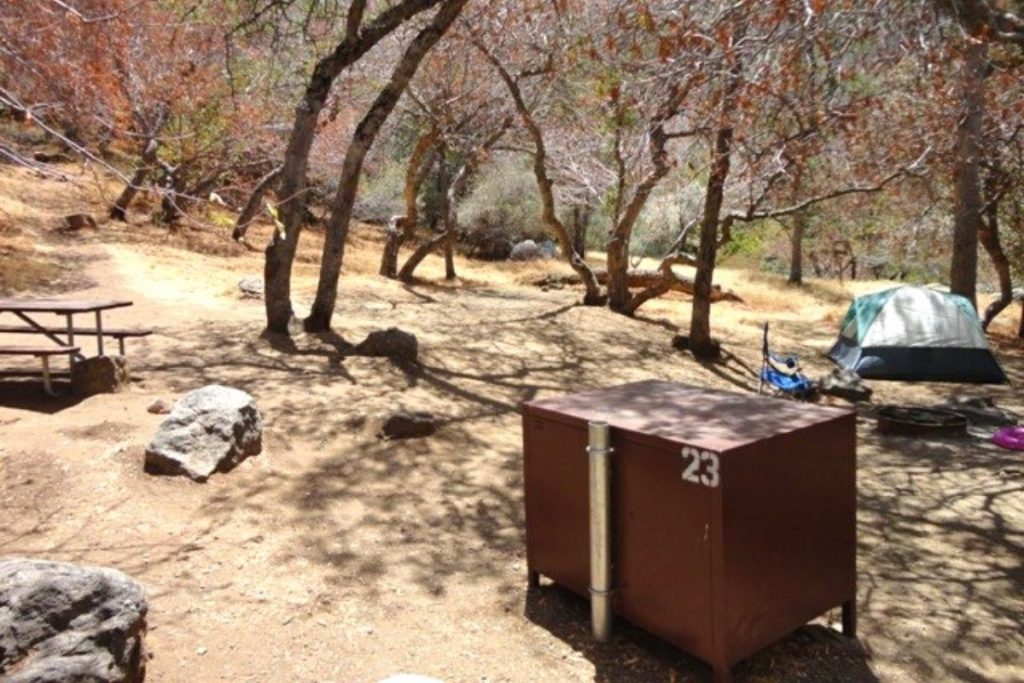
Tips for Sequoia the Best Hiking in Sequoia National Park
- Sequoia National Park charges an entry fee. However, to save time when entering the park, you can use the annual national park pass. The pass gets you into both Sequoia and Kings Canyon, plus 400 more national park sites. Get your annual national park pass here for only $80.
- Cell service is limited in most areas of the park. Be sure to download your lodging reservation details or take a screenshot before arriving at the park. For hikes, I highly recommend AllTrails Pro to download your hike details and navigate without cell service.
- Sequoia National Park is in black bear country. Protect wildlife by giving plenty of space if you do come across them. Also, be sure to make plenty of noise on less crowded trails to alert animals of your presence. You can read more here about bear safety in Sequoia.
- Pets are not allowed on hiking trails and cannot be left unattended. Read more about pets in Sequoia National Park.
- Backpacking in Sequoia National Park requires a wilderness permit. You can get this permit up to 6 months in advance via Recreation.gov. Day hikes do not require a permit.
- Sequoia National Park offers a few restaurants and markets for eating in the park. You can stop in at these spots for a quick bite between hikes:
Read More: Best Time to Visit Sequoia National Park
Best Easy Hiking Trails in Sequoia National Park
Sequoia National Park offers several easy hikes, a few of which are handicap accessible. These trails take you to some of the most popular attractions in the park, like the General Sherman Tree and Giant Forest Museum.
If you’re looking for family-friendly or low-impact hikes, these are for you!
General Sherman Tree Trail
- Area of Park: Giant Forest & Lodgepole
- Distance: 1.2 miles
- Elevation: 196 feet
- Time: 30 minutes
- Check out on AllTrails
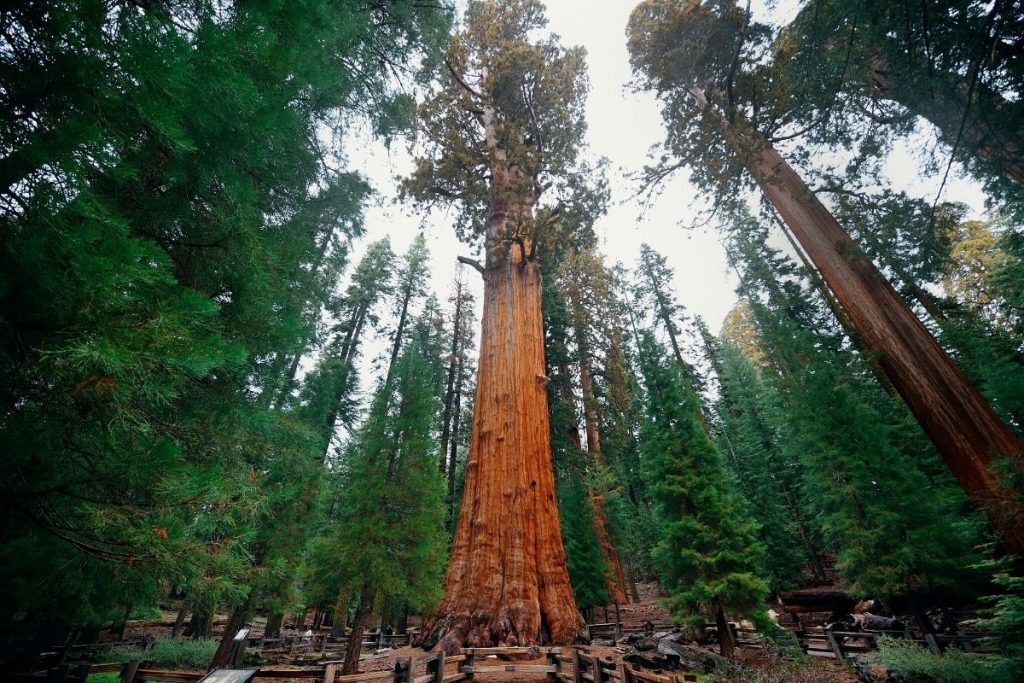
The General Sherman Tree is famous for being the largest tree in the world. At over 17 feet wide and 275 feet tall, this giant Sequoia has a volume of over 50,000 cubic feet.
Over a thousand years, it’s easy to see why General Sherman draws so many visitors.
The best way to visit this famous Sequoia is on a short hike from Wolverton Road. The parking lot here is the perfect place to start your adventure to the world’s biggest tree.
From the trailhead, the path to General Sherman Tree is an easy trail 1-mile round trip. While the trail is easy overall, there is elevation as you climb back up to the parking lot after seeing the tree.
General Sherman Tree is also one of the few accessible trails in the park. Those with valid handicap parking decals can park in an accessible parking lot along General Highway. The short hike here is entirely paved and only 0.25 miles roundtrip.
Sequoia National Park runs a shuttle throughout this park area in the summer, stopping at the General Sherman Tree accessible trailhead. The shuttle allows visitors to see the tree on a shorter hike instead of parking at the further away trailhead.
This trail is easily the most crowded in the park. It’s common to see long lines to get a picture in front of the tree. I think this hike is a must-do to see the largest trees in the world, but I don’t recommend spending all your time here.
Want to see more giant Sequoias? Don’t miss the General Grant Tree in nearby Kings Canyon National Park!
Read More: 8 Best Hikes in Kings Canyon National Park
Big Trees Trail
- Area of Park: Giant Forest & Lodgepole
- Distance: 1.3 miles
- Elevation: 114 feet
- Time: 30 minutes
- Check out on AllTrails
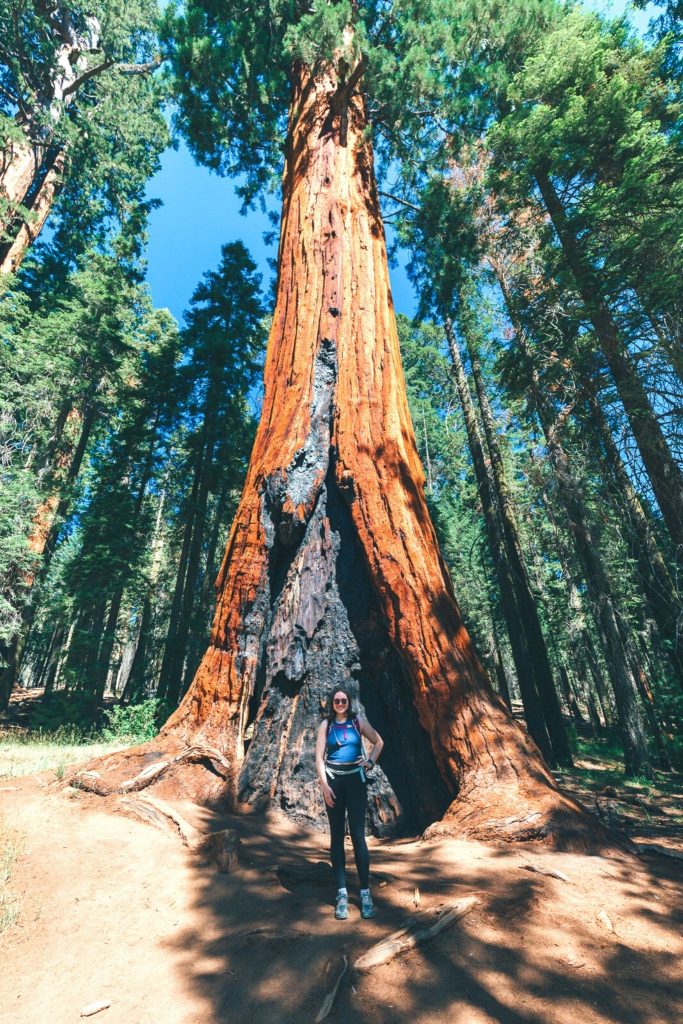
The Big Trees Trail is the second most popular trail in the park, after General Sherman Tree. This scenic trail takes you through the Giant Forest, one of the most extensive groves of Sequoias in the world.
Here you can see several giant Sequoias on an easy access trail.
The trail weaves through the Round Meadow, lined with ancient Sequoias. Along the way, you’ll find plenty of detailed markers and displays to help you learn more about the giant Sequoias.
Start your hike at the Giant Forest Museum. In the summer, I highly recommend getting here before 9 AM to find a parking spot.
Then, when the shuttles are running, you can take the shuttle to other areas of the park throughout the day to avoid having to search for a new parking spot.
Big Trees Trail is also handicap accessible since the trail is a boardwalk path. Those with valid handicap parking decals can park at the trailhead instead of the further away lot at the Giant Forest Museum.
After the hike, be sure to stop in at the Giant Forest Museum to learn more about Sequoias and their habitat!
Are you planning a national park trip but don’t know where to start? Get my free 28-page national park ebook where I break down everything you need to know to visit all 63 USA national parks.
Download your free ebook here.
Congress Trail
- Area of Park: Giant Forest & Lodgepole
- Distance: 3.0 miles
- Elevation: 495 feet
- Time: 1.5 hours
- Check out on AllTrails
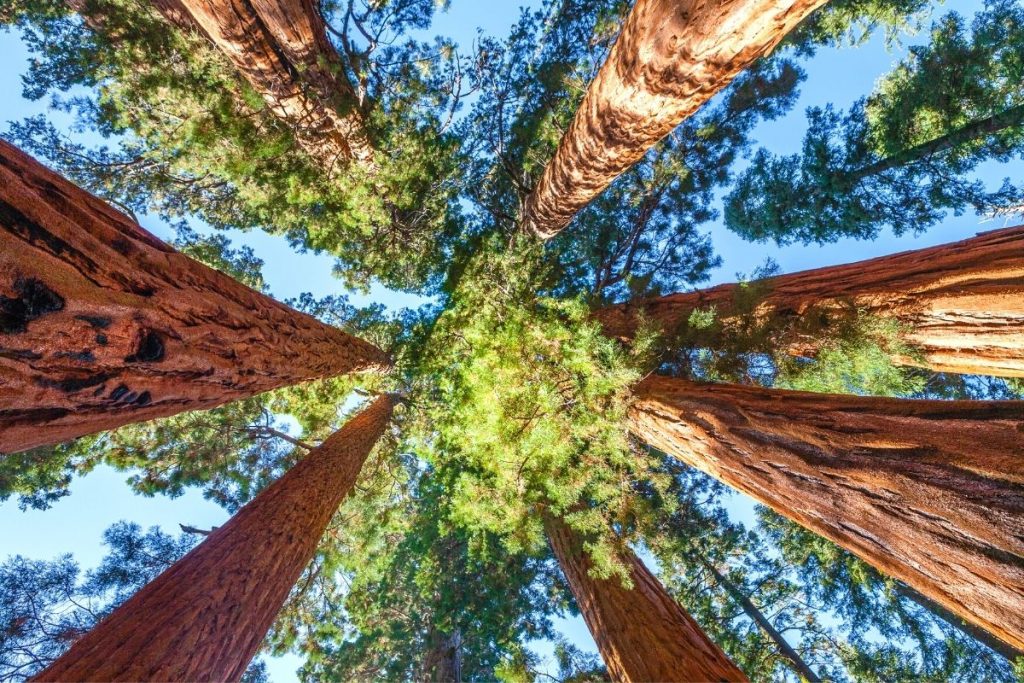
To see more Sequoias and escape the crowds around the General Sherman Tree, add on the Congress Trail! This hike starts at the same trailhead as General Sherman Tree, passing the giant and looping out to two other Sequoia groves.
In this part of the park, the groves and largest Sequoias are named after former U.S. presidents, generals, and both houses of congress (as the name of the trail implies!).
Don’t miss the President Tree and the McKinley Tree! For impressive views of tightly clustered Sequoias, you can visit both The House and The Senate.
Compared to the crowds around the General Sherman Tree, the Congress Trail takes you to equally as impressive views with significantly fewer crowds.
Only steps onto the path past General Sherman, crowds disappear, and you’ll have space to spread out and enjoy the forest.
The trail is mostly easy, with a few sections of moderate elevation gain. However, it’s important to note that this park area is at high elevation, so be sure to take your time and stay hydrated if you start feeling tired.
The trailhead starts at the parking area off Wolverton Road. If you’re taking the park shuttle from the Giant Forest Museum, you can start from the General Sherman Tree accessible lot instead.
Crescent Meadow Loop Trail
- Area of Park: Giant Forest & Lodgepole
- Distance: 1.8 miles
- Elevation: 206 feet
- Time: 1 hour
- Check out on AllTrails
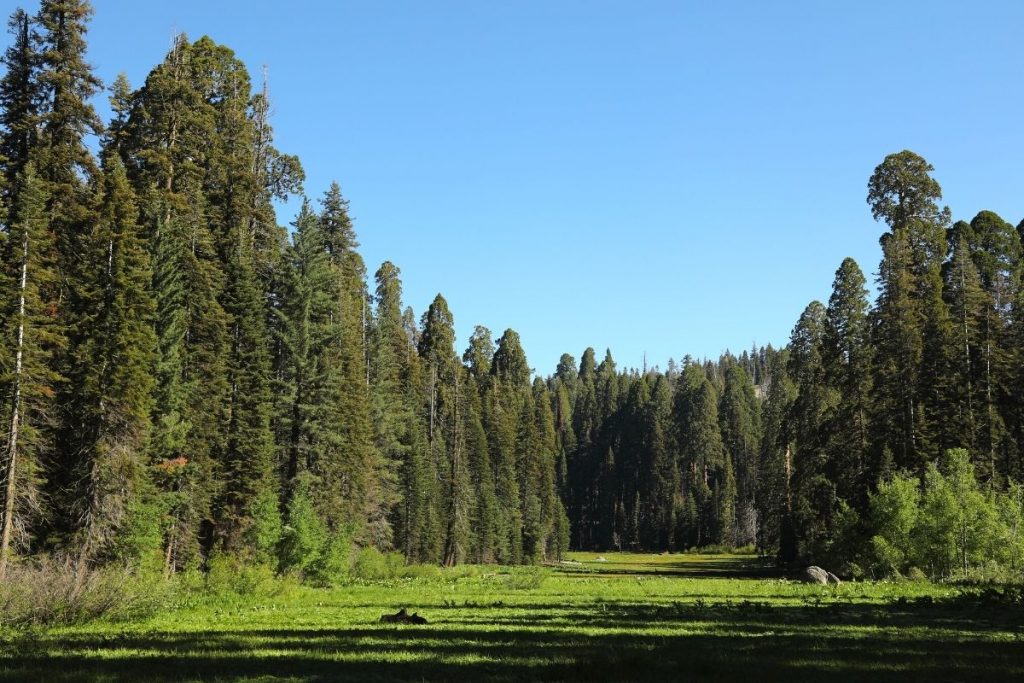
In many areas of the park, Sequoia groves surround expansive grassy meadows. These meadows provide much-needed water for the Sequoias to grow.
However, none is more impressive than Crescent Meadow. John Muir called this part of the park the “gem of the Sierras.”
The trail starts at the end of Crescent Meadow Road and is also a popular trailhead for backpackers venturing on the High Sierra Trail. Along the route, you follow a loop along the edges of the meadow.
Don’t miss two landmarks along the way – Tharp’s Log, a hollowed-out Sequoia converted into a log cabin, and Chimney Tree, a still-standing log hollowed out by a fire.
For a longer, more strenuous hike, you can connect the Crescent Meadow trail to the Congress Trail and the General Sherman Tree on the Trail of the Sequoias (you can read more about it in the section on moderate hikes below).
In the summer, the road to the trailhead is closed to private vehicle traffic during the day, and all visitors must take the park shuttle to reach Crescent Meadow and nearby Moro Rock.
I recommend parking at the Giant Forest Museum for the day and taking the shuttle from there.
Moderate Best Hikes in Sequoia National Park
The easy hikes in Sequoia National Park bring plenty of crowds thanks to their accessibility. However, if you’re looking to escape some crowds and take a more challenging walk, these moderate trails are for you!
Moro Rock Trail
- Area of Park: Giant Forest & Lodgepole
- Distance: 0.5 miles
- Elevation: 177 feet
- Time: 30 minutes
- Check out on AllTrails

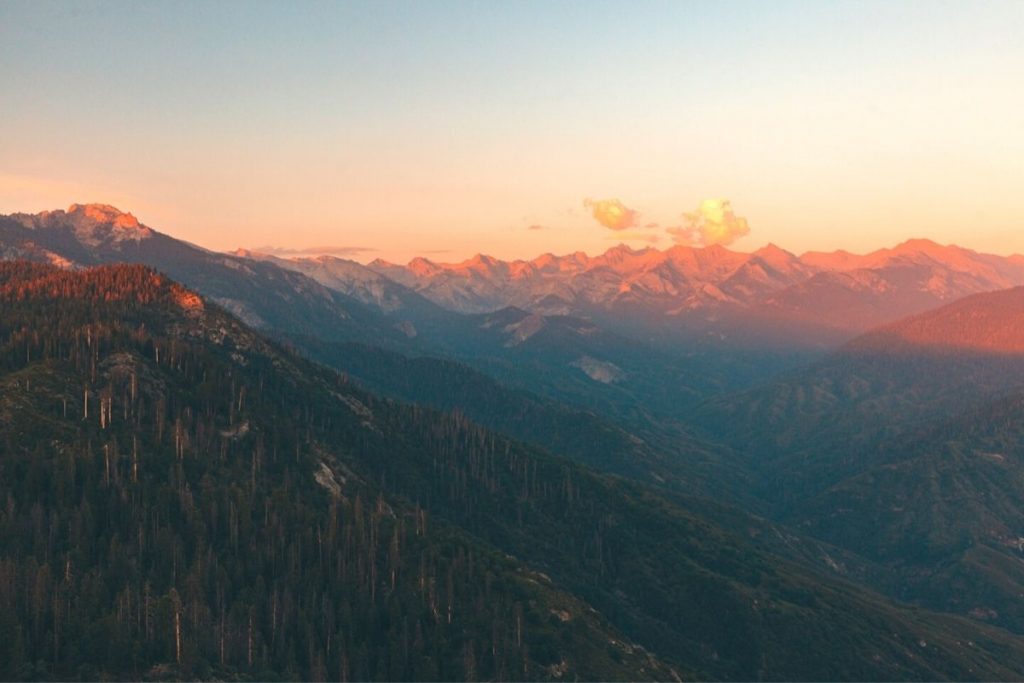
Moro Rock is one of the most popular destinations in Sequoia National Park for sunset. The surrounding valleys and mountains turn pink, purple, and orange shades as the light fade away.
So if you’re looking for an epic sunset hike with panoramic views, don’t miss Moro Rock.
This unique rock formation is a giant, natural slab of granite. A stairway built into the rock climbs several hundred feet to the summit. The hike to the top of Moro Rock is no joke – it climbs nearly 40 flights of stairs!
While it’s only a short distance, the steep elevation gain will have you out of breath.
You’ll have views overlooking the Great Western Divide to the north and the western part of the park from the summit. The other way, you’re looking at the distant Sierras to the east.
At sunset, you can drive directly to the Moro Rock trailhead, through the famous Tunnel Log. During the day, the road to Moro Rock is closed to vehicle traffic, and only park shuttles are allowed on this route.
If you want to visit Moro Rock before sunset, I recommend taking the shuttle from the Giant Forest Museum instead.
While the summit of Moro Rock does have some guard rails, it’s not for those with extreme fear of heights. However, if heights aren’t your thing, there are several spectacular viewpoints along the hike with less severe drop-offs before you reach the summit.
Giant Forest Loop
- Area of Park: Giant Forest & Lodgepole
- Distance: 7.0 miles
- Elevation: 1,272 feet
- Time: 3 hours
- Check out on AllTrails
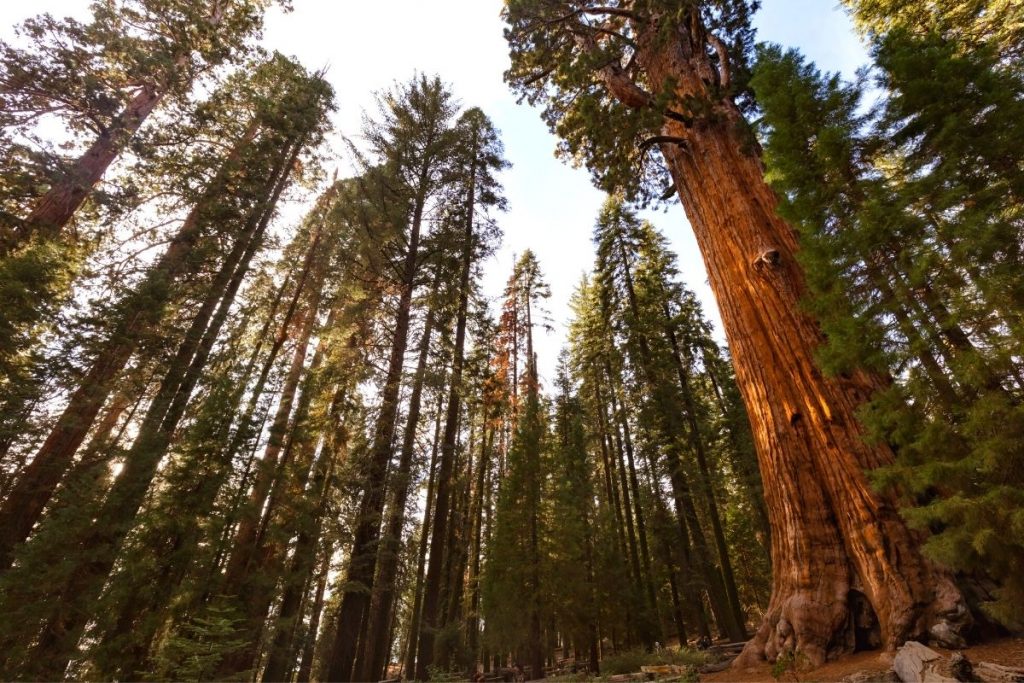
To explore the Giant Forest and its Sequoias beyond just the famous, short trails, take a hike along the Giant Forest Loop instead! Totaling 7 miles, this trail takes you to famous landmarks such as General Sherman Tree, Congress Groves, Tharp’s Log, and Crescent Meadow.
You’ll see the best parts of the Sequoia trees and be able to escape the crowds that surround popular spots like Congress and General Sherman. While this trail is long, it’s still ranked as easy since it has minimal elevation gain.
Tokopah Falls Trail
- Area of Park: Giant Forest & Lodgepole
- Distance: 4.0 miles
- Elevation: 639 feet
- Time: 2 hours
- Check out on AllTrails
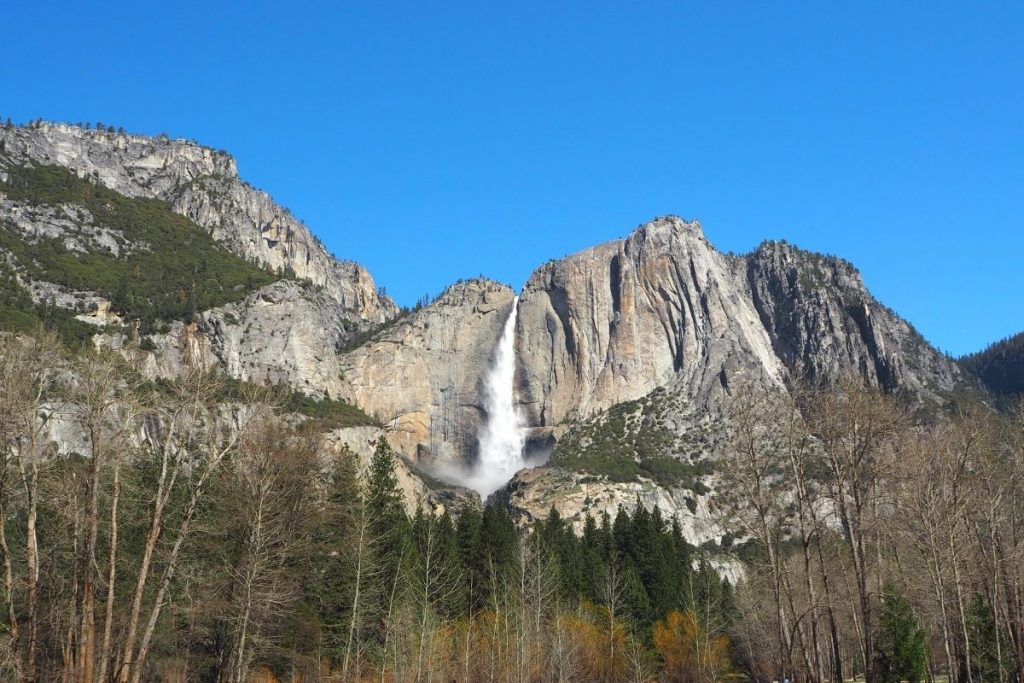
Tokopah Falls is one of the few waterfall hikes in Sequoia National Park. Starting from Lodgepole Campground, it’s the perfect hike for those staying in the area or taking the park shuttle (which stops at Lodgepole).
The trail follows a fork of the Kaweah River along granite cliffs out to a large waterfall. In late spring to early summer, the waterfall gushes at full force, fueled by snowmelt. However, by late summer and into fall, Tokopah Falls flow slows significantly.
Overall, the trail is primarily flat with beautiful scenery out to the 1,200-foot waterfall. Be sure to keep your eyes peeled for wildlife along the hike!
With very little elevation change and idyllic scenery, Tokopah Falls is one of the most popular hiking trails in Sequoia. The trail runs parallel to the Kaweah River, past towering granite cliffs to the gorgeous Tokopah Falls.
Cascading down 1,200 feet, the falls make for a beautiful place to have a picnic. Early in the season, the falls are stunning. However, going later in the year (September), the falls may only be a trickle.
Looking for more waterfall hikes? Don’t miss Mist Falls in nearby Kings Canyon National Park!
Read More: 8 Best Hikes in Kings Canyon National Park
Little Baldy
- Area of Park: Generals Highway Between Sequoia & Kings Canyon
- Distance: 3.3 miles
- Elevation: 793 feet
- Time: 2 hours
- Check out on AllTrails
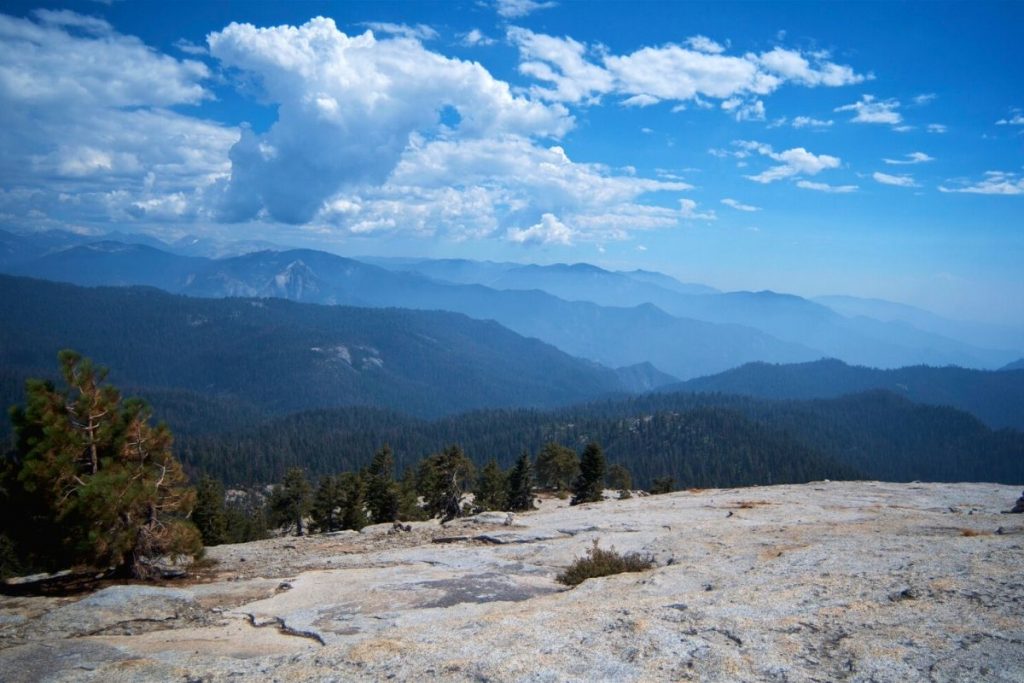
For a short but steep path to spectacular views, take the hike to Little Baldy. This trail climbs switchbacks up to the top of a peak called Little Baldy.
From the summit, you have views overlooking the western part of the park and the Great Western Divide, a natural border between Sequoia and Kings Canyon.
Keep your eyes peeled for nature along the hike, like marmots and notable rock formations like Big Baldy and Chimney Rock.
Marble Falls Trail
- Area of Park: Foothills
- Distance: 7.4 miles
- Elevation: 1,627 feet
- Time: 4 hours
- Check out on AllTrails
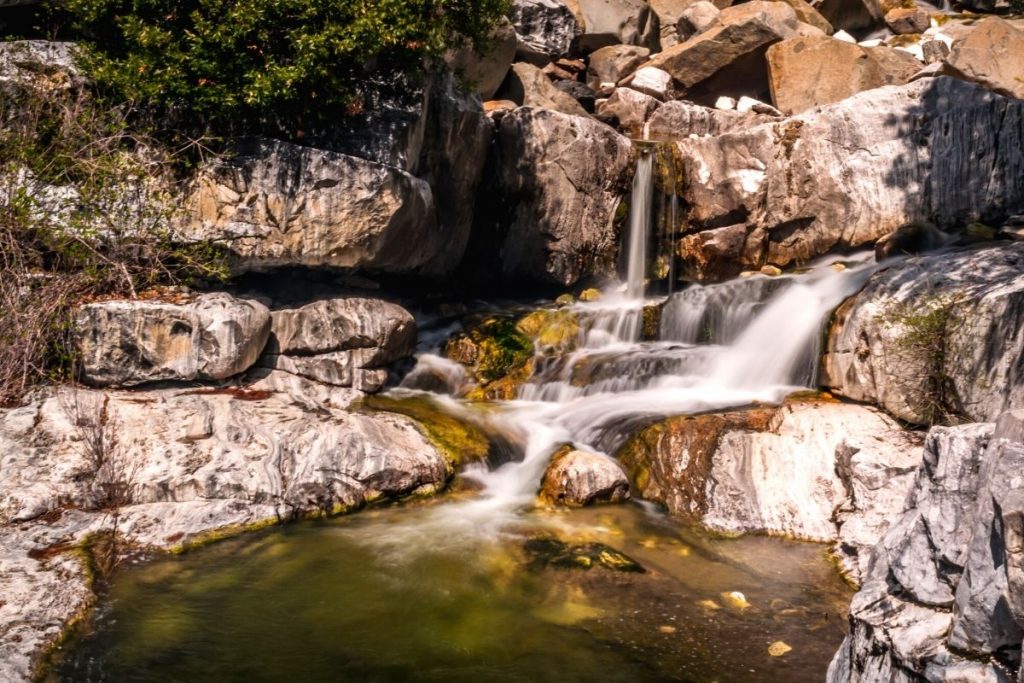
For a more difficult and less popular waterfall hike than Tokopah Falls, opt for Marble Falls instead. The trail starts in Potwisha Campground in the Foothills region of the Sequoia National Park.
If you’re staying in this part of the park, this is an excellent option.
The trail guides you through deep canyons and up more than 1,500 feet of elevation to the waterfall. While not as impressive as Tokopah Falls, this cascade offers different views along the way and is the best place for a picnic after a strenuous hike.
The Foothills region gets very hot in the summer. Therefore, I highly recommend hiking this trail in the off-season or first thing in the morning to avoid the heat.
Read More: Best Time to Visit Sequoia National Park
Crystal Cave Trail
- Area of Park: Giant Forest & Lodgepole
- Distance: 0.8 miles
- Elevation: 291 feet
- Time: 30 minutes
- Check out on AllTrails
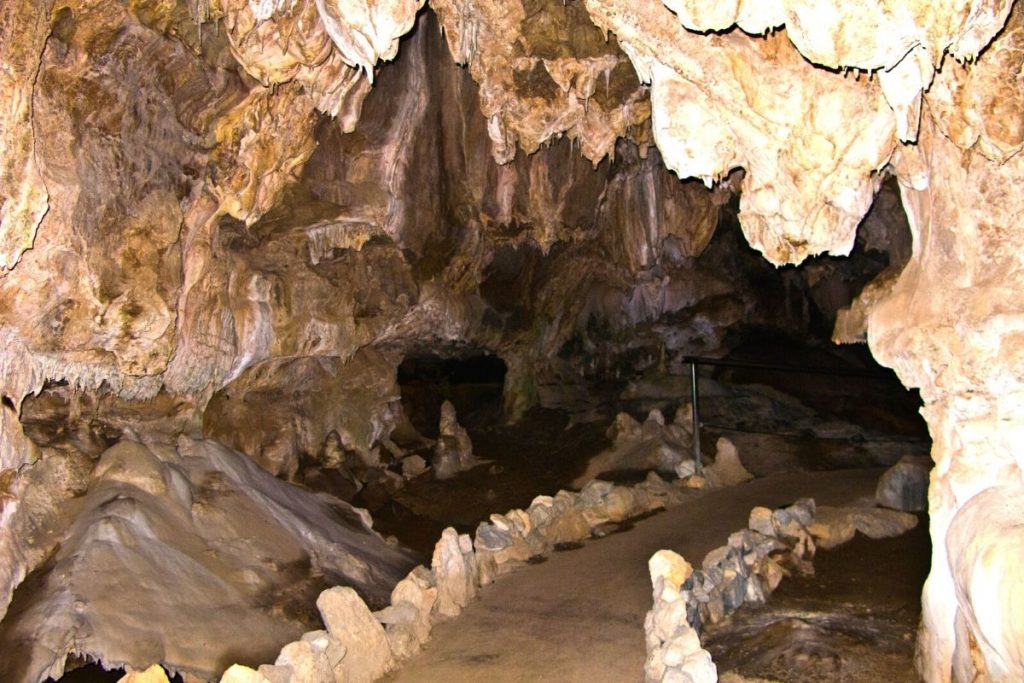
Did you know Sequoia National Park has a famous cave? Crystal Cave is a deeply carved marble cavern in the heart of Sequoia National Park.
A hike through Crystal Cave requires a tour as the area isn’t open to unaccompanied visitors. However, you can book tickets for the tour via Recreation.gov.
A tour guide navigates you through the winding cave past the Spider Web Gate, allowing you to experience the mystical cave in total darkness. The trail to the cave entrance is steep, so be prepared for a challenge ahead of the tour.
Big Baldy Ridge Trail
- Area of Park: Generals Highway Between Sequoia & Kings Canyon
- Distance: 6.0 miles
- Elevation: 1,473 feet
- Time: 2 hours
- Check out on AllTrails
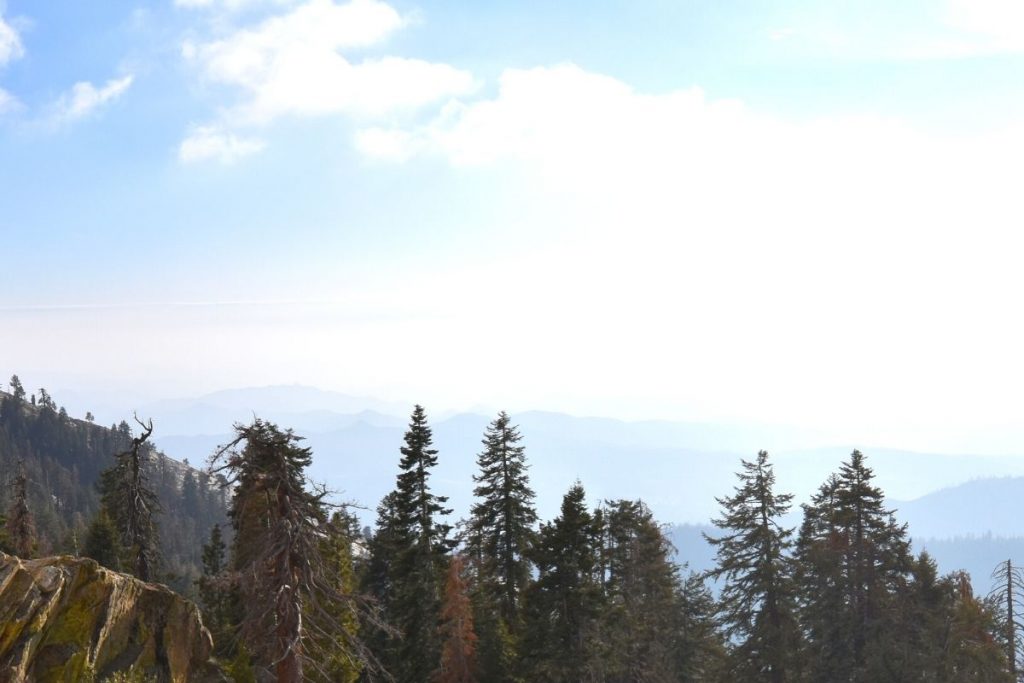
Big Baldy Ridge is a popular choice for those making the trip from Sequoia to Kings Canyon National Park. Roughly halfway between Giant Forest and Grant Grove, it’s an excellent midpoint hike.
The trail to the summit of Big Baldy takes you to 360-degree views. You can overlook both Sequoia National Park to the south and Kings Canyon National Park to the north from the top.
Don’t miss views of Castle Peak, the Great Western Divide, Alta Peak, and Sawtooth Peak!
While the hike does provide a bit of challenge with elevation, it is not a strenuous hike for average hikers. In the early summer, you may even spot some wildflowers along the trail!
Read More: 8 Best Hikes in Kings Canyon
Trail of the Sequoias
- Area of Park: Giant Forest & Lodgepole
- Distance: 7.5 miles
- Elevation: 1,368 feet
- Time: 4 hours
- Check out on AllTrails
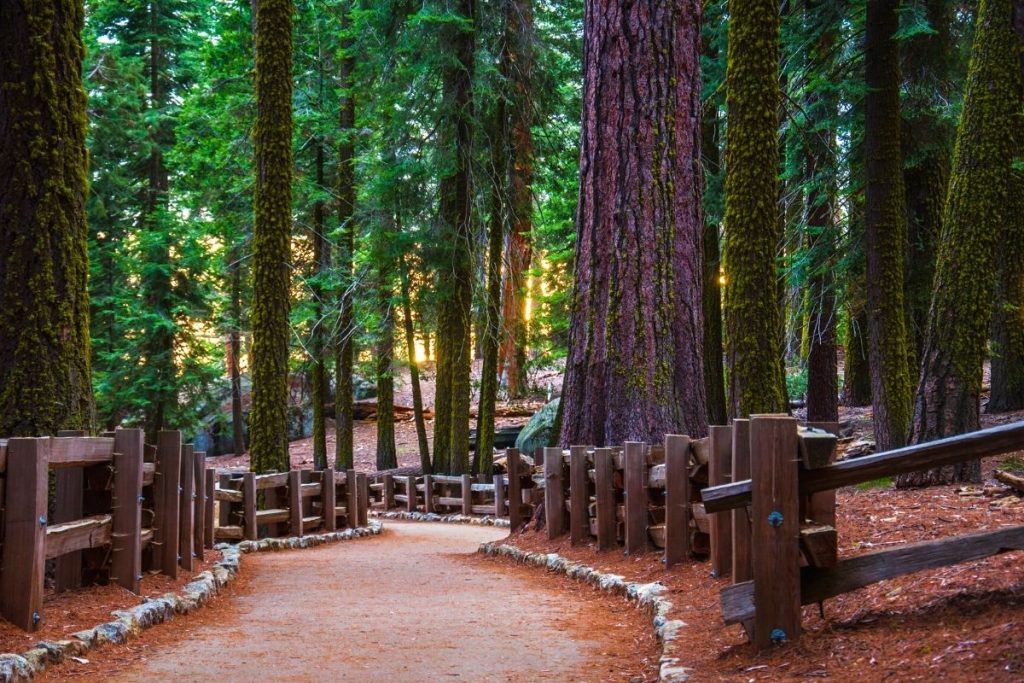
There are seemingly endless trails to explore the Sequoias in the Giant Forest. However, you can escape the crowds found near General Sherman and the Congress Trail with this add-on along the Trail of the Sequoias.
Trail of the Sequoias starts and ends at the General Sherman Tree Trailhead, taking you past this marvel and many more giant Sequoias on the loop out to Crescent Meadow.
Don’t miss the Congress Group, Tharp Log, and Chimney Tree along the route!
Similar to the Giant Forest Loop, this trail provides extra distance and elevation for a challenge. However, you’ll find solitude amongst the redwoods as you escape the crowds on the shorter, more accessible trails with the additional challenge.
Strenuous Best Trails in Sequoia National Park
Many of the popular trails in Sequoia National Park are rated as easy to moderate as they take you through rolling Sequoia forests. However, for a strenuous, challenging hike, you’ll want to venture to the Sierra Nevada peaks within the park.
Alta Peak Trail
- Area of Park: Giant Forest & Lodgepole
- Distance: 14.9 miles
- Elevation: 4,064 feet
- Time: 9 hours
- Check out on AllTrails
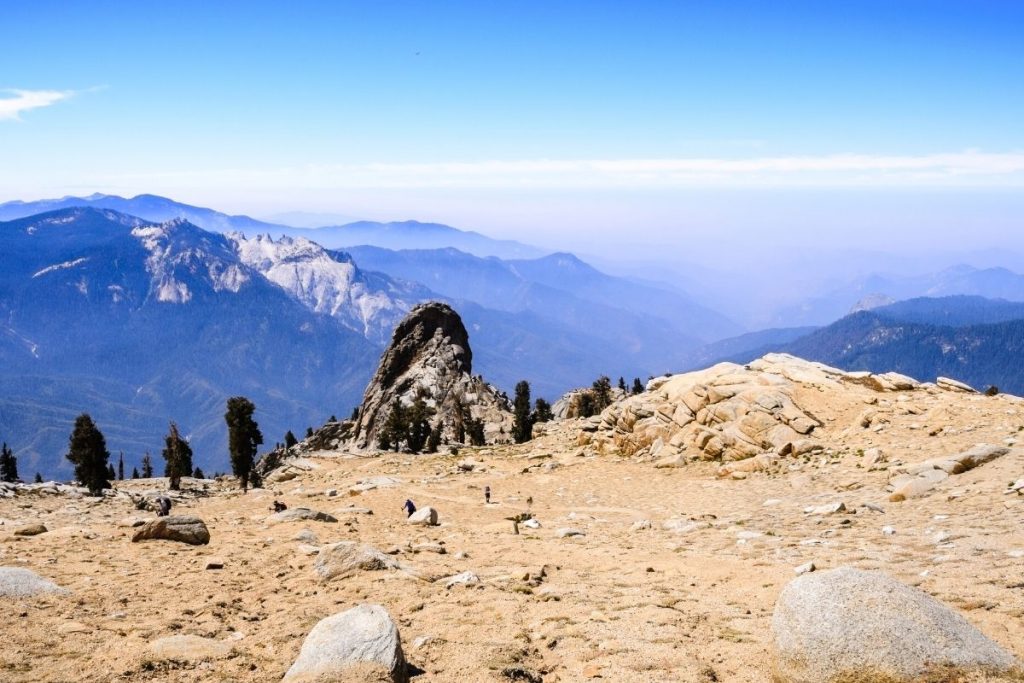
One of the best peaks in Sequoia National Park is Alta Peak. Located just south of Lodgepole Campground in the heart of the park, it’s the perfect hike for those looking for a challenging hike without venturing out to Mineral King.
The trail takes you up 4,000 feet in nearly 15 miles to the top of Alta Peak. Before this hike, you should acclimate to the elevation. The trail starts at over 7,000 feet and ends at the summit of Alta Peak, over 11,000 feet high!
On a clear day, you can overlook the expansive mountains and valleys in Sequoia National Park. You can even see Mount Whitney, the tallest mountain in the lower 48!
Franklin Lakes Trail
- Area of Park: Mineral King
- Distance: 11.2 miles
- Elevation: 3,458 feet
- Time: 7 hours
- Check out on AllTrails
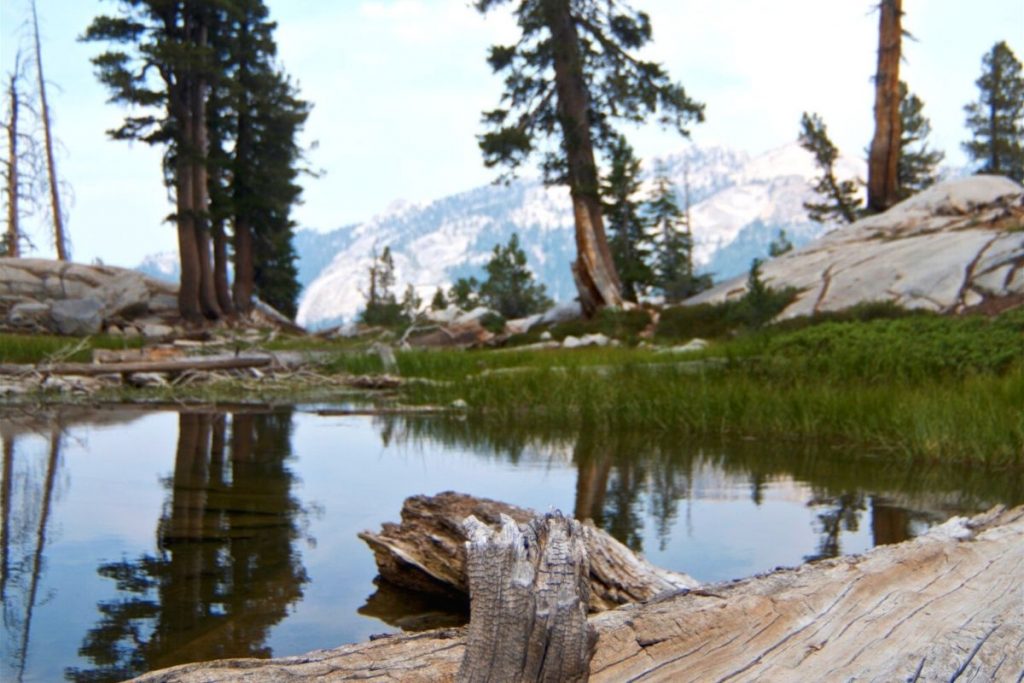
Franklin Lakes is a popular overnight trail that can also be done as a day hike. The trail starts in the Mineral King area of Sequoia National Park. From the Mineral King Ranger Station, you’ll steadily climb nearly 3,500 feet in 7 miles.
The trail reaches its peak at Franklin Lakes. Here you’ll find three alpine lakes nestled amongst the surrounding Sierra peaks. After taking time to relax, day hikers can return to the trailhead.
Backpackers can choose to continue to explore more of the Sierra Nevadas.
Mineral King Trail to Eagle Lake
- Area of Park: Mineral King
- Distance: 6.5 miles
- Elevation: 2,214 feet
- Time: 4 hours
- Check out on AllTrails
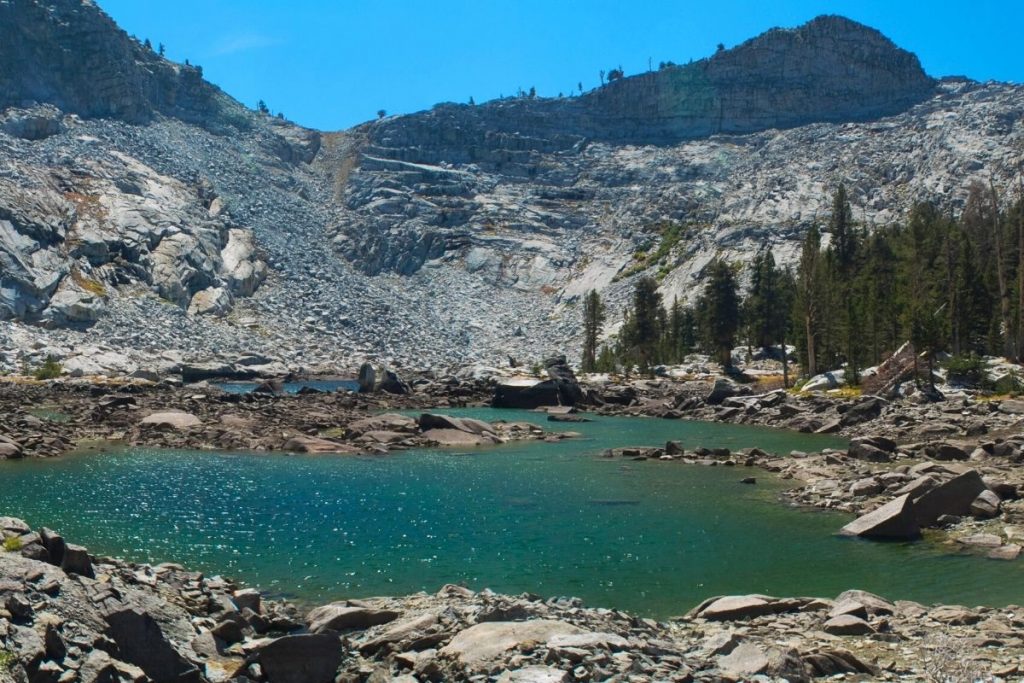
Mineral King is home to the best alpine hikes in Sequoia National Park. While not as long as the other favorite hikes, the trail to Eagle Lake packs in plenty of elevation.
The trail climbs steadily from the end of Mineral King Road. As you hike, you’ll pass a turn-off trail for another alpine lake, Mosquito Lake. A side trip here adds roughly 3 miles to your hike.
At Eagle Lake, you’ll have quiet alpine lake relaxation, views of the Sierras, and chances to spot wildlife like marmots!
Best Backpacking in Sequoia National Park
Backpacking in the Sierra Nevada is one of the best ways to see Sequoia National Park off the beaten path. These trails are strenuous, but manageable when broken up over several days.
Lakes Loop to Heather Lake, Emerald Lake, and Pear Lake
- Area of Park: Giant Forest & Lodgepole
- Distance: 12.3 miles
- Elevation: 2,936 feet
- Time: 6 hours
- Check out on AllTrails
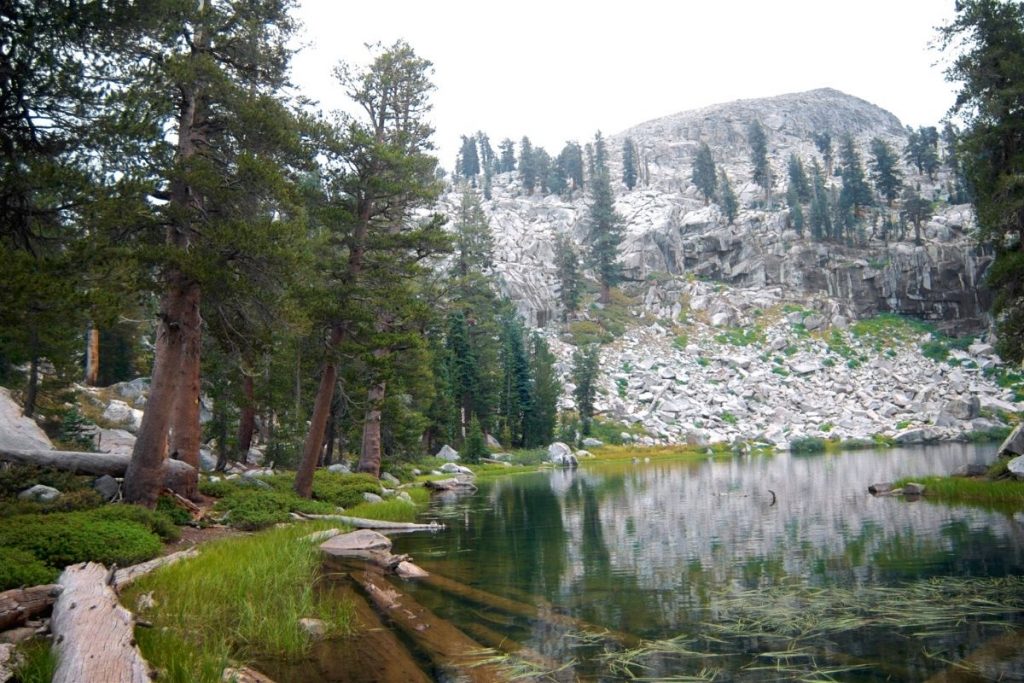
The Lakes Loop is one of the most popular backcountry trails in Sequoia National Park. It starts from the overflow parking lot off Wolverton Road, also commonly used to reach the General Sherman Tree.
While described as a “loop,” this trail is an out-and-back. You’ll hike past three beautiful alpine lakes before returning to the trailhead. The trail starts in a forested area while steadily climbing to Heather Lake, Emerald Lake, and Pear Lake.
About 4 miles from the trailhead and plenty of elevation later, you’ll reach Heather Lake. Another mile of hiking rewards you with a peaceful view of Emerald Lake.
This lake is a popular spot for backpackers to camp overnight (although campsites are available at Emerald and Pear Lakes). From here, it’s only another 1.5 miles to reach the last and biggest lake on the trail – Pear Lake.
If you’re looking for a shorter hike, you can choose only to go as far as Heather Lake and return on a popular day hike.
Monarch Lakes Trail
- Area of Park: Mineral King
- Distance: 8.4 miles
- Elevation: 2,650 feet
- Time: 5 hours
- Check out on AllTrails
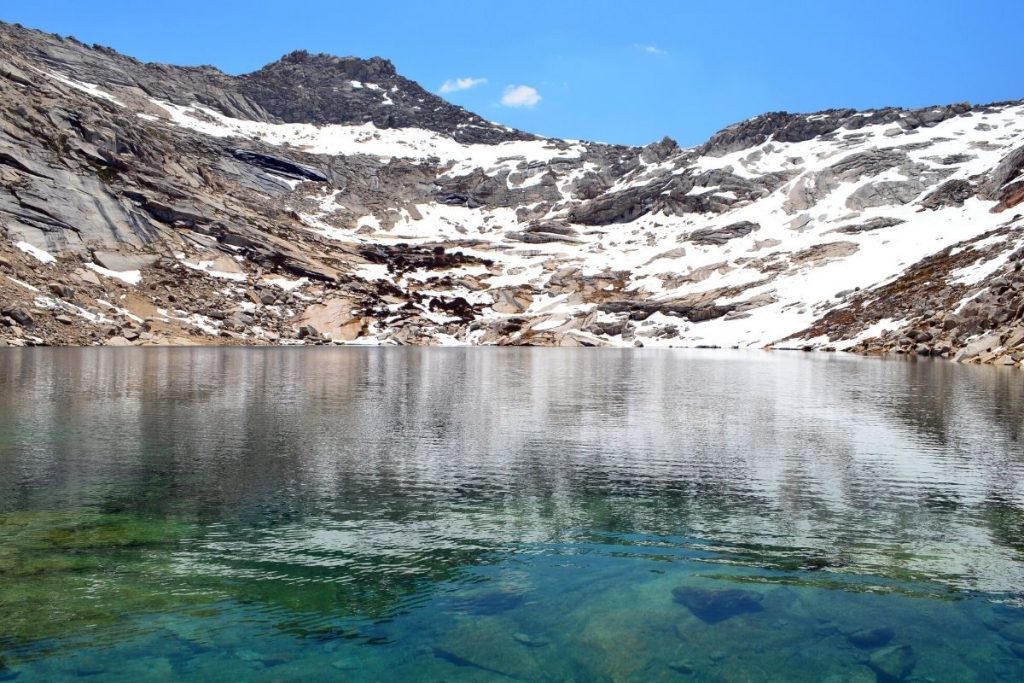
If you’re looking for a challenging but incredibly scenic one-night backpacking trip, don’t miss the Monarch Lakes Trail. Starting at the end of Mineral King Road, the trail takes you through forests and meadows until you reach the alpine lake after about 4 miles.
Monarch Lakes is comprised of both an upper and a lower lake, with plenty of options for backcountry camping nearby.
For those looking for a more strenuous overnight hike, you can continue to Sawtooth Pass and Columbine Lakes. Here you’ll find even more solitude as day hikers rarely make it this far.
Mount Langley
- Area of Park: Mineral King
- Distance: 23.0 miles
- Elevation: 4,688 feet
- Time: 12 hours
- Check out on AllTrails
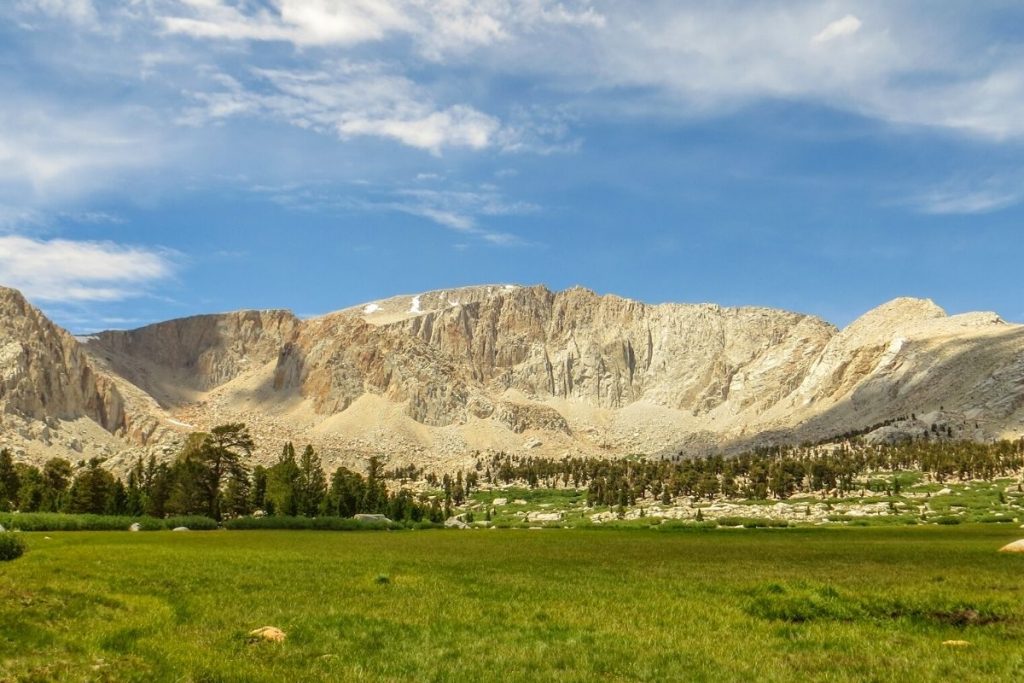
Mount Langely is the 9th highest peak in California and one of California’s 14er mountains. Standing at 14,026 feet, Mount Langely is often overshadowed by the other tall peak in Sequoia & Kings Canyon National Park – Mount Whitney.
If you aren’t up for the incredibly strenuous climb up Mount Whitney, consider getting a backcountry permit and hiking Mount Langely instead.
The 23-mile hike can be completed over two days for seasoned hikers and doesn’t require any technical climbing skills.
Frequently Asked Questions About Hiking in Sequoia National Park
What is the best hike in Sequoia National Park?
The best hike in Sequoia National Park will depend on your interest and skill level. Popular easy trails include the General Sherman Tree and Big Tree trails. If you’ve got some hiking experience, don’t miss Moro Rock and the Giant Forest Loop.
How many hiking trails are in Sequoia National Park?
There are more than 50 hiking trails in Sequoia National Park, covering hundreds of miles. This guide covers the 18 best hikes in Sequoia National Park, perfect for choosing a trail for your first-time visit to Sequoia.
Is it safe to hike in Sequoia?
Most trails in Sequoia National Park are safe to hike. Always be sure to read up on the trail ahead of time, and don’t attempt a trail for which you are unprepared. Be sure to pack the ten hiking essentials, plenty of water, and layers when hiking in Sequoia National Park.
Do I need bear spray in Sequoia?
Bear spray is not allowed in any California national parks, including Sequoia National Park. The only bears found here are less aggressive black bears. However, bear safety is still important, so always be sure to store food properly and make noise on less populated trails.
Final Thoughts on the Best Hike in Sequoia National Park
Sequoia National Park has a hike for everyone, from strolls through Sequoia groves to summiting mountains in the Sierras! There’s no shortage of excellent trails to explore in this forested national park.
These are the 18 best hikes in Sequoia National Park:
- General Sherman Tree
- Big Trees Trail
- Congress Trail
- Crescent Meadow Loop
- Moro Rock
- Giant Forest Loop
- Tokopah Falls
- Little Baldy
- Marble Falls
- Crystal Cave
- Big Baldy Ridge Trail
- Trail of the Sequoia
- Alta Peak
- Franklin Lakes Trail
- Mineral King Trail to Eagle Lake
- Lakes Loop Trail
- Monarch Lakes Trail
- Mount Langley
Looking for more ideas for your trip to Sequoia and Kings Canyon? Check out these posts!
- Best Time to Visit Sequoia National Park
- 7 Best Campgrounds in Sequoia National Park
- 8 Best Hikes in Kings Canyon National Park
- 7 Best Campgrounds in Kings Canyon
Are you planning a national park trip but don’t know where to start? Get my free 28-page national park ebook where I break down everything you need to know to visit all 63 USA national parks.
Download your free ebook here.
Don’t Forget to Save This Post on Pinterest
